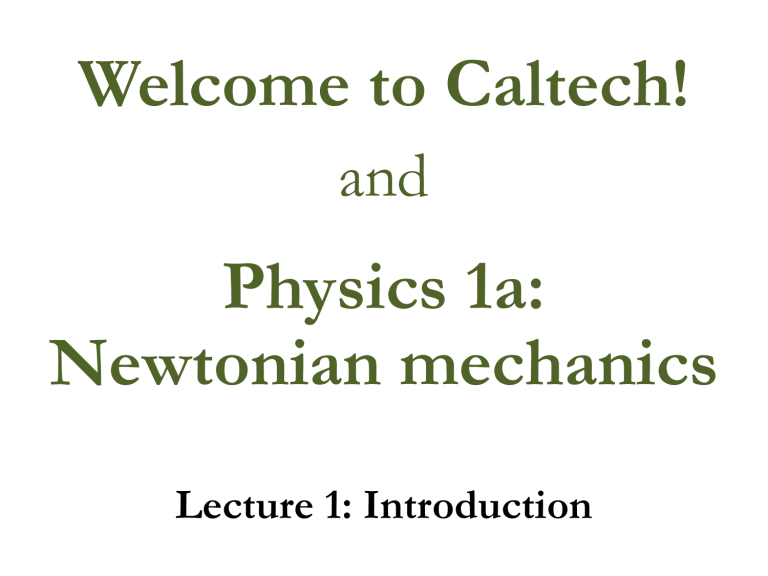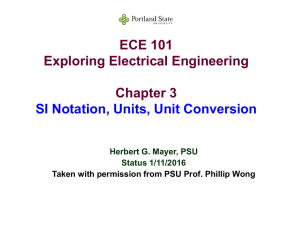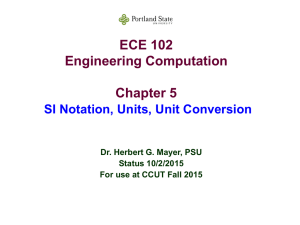Welcome to Caltech! Physics 1a: Newtonian mechanics
advertisement

Welcome to Caltech! and Physics 1a: Newtonian mechanics Lecture 1: Introduction Basic info Ryan Patterson, rbpatter@caltech.edu Office: Lauritsen 339, x5753 Lectures: Wed and Fri, 11am 201 E. Bridge (a.k.a. Feynman Lecture Hall) Sections: Mon and Thu, 1pm or 3pm, various locations and instructors. Office hours: Various times, locations, and instructors (see webpage) Course webpage http://www.its.caltech.edu/~tmu/ph1a/ Course webpage http://www.its.caltech.edu/~tmu/ph1a/ Past quiz and final exam problems (many assigned as homework) General information Lecture notes, quizzes, and other documents Course calendar On the course webpage… Required reading Homework assignments Quizzes Table from last page of PDF syllabus. Check there for updates. Material overview All of this in Introduction about 9 weeks 1D motion Falling bodies, acceleration Reference frames, 2D motion Newton's laws Forces of nature Circular motion Non-inertial frames Energy Linear momentum Angular Momentum Rotational dynamics Oscillatory motion Orbits, Kepler's laws Fluid Mechanics Gyroscopes Material overview A lot will be covered in a short amount of time. All of this in Introduction about 9 weeks 1D motion Some things may seem hard; Falling bodies, acceleration some easy. Stay on your toes! Reference frames, 2D motion Take advantage of: Newton's laws Reading, Lectures, Sections Forces of nature and Circular motion Office hours, Core study sessions Non-inertial frames Energy Office hours Linear momentum Times (typically on Tuesday) and locations are listed on the course webpage (some still Angular Momentum to be filled in) Rotational dynamics Oscillatory motion Core study sessions This is a new thing this year! Undergraduate Orbits, Kepler's laws tutors will be on hand Monday 8pm – 11pm Fluid Mechanics on the 9th floor of Millikan. (Monday is Gyroscopes physics. Other subjects are on others days.) http://xkcd.com/435/ http://xkcd.com/435/ Figuring out how the universe works http://xkcd.com/435/ Figuring out how the universe works - The primary material in this course is about three centuries old. - But, one has to begin at the beginning… Ph 1 Ph 1 Engineering Biology Geosciences Chemistry Physics etc… Astronomy Ph 1 Essential math We will need these tools right out of the gate. Some calculus notation differentiation sum rule, product rule, etc. integration finding minima and maxima Vectors notation components, magnitudes algebraic manipulations dot product, projections cross product unit vectors The first set of required reading is longer than usual because it includes reviewing these topics (Chapters 3 and 5). Even if it’s just to shake the rust off, you should review this material! SI units Stay consistent ⇒ less work & fewer mistakes length : meter (m) time : second (s) mass : kilogram (kg) Fundamental SI units SI units Stay consistent ⇒ less work & fewer mistakes length : meter (m) time : second (s) mass : kilogram (kg) velocity : m/s accel. : m/s2 area : m2 etc… Fundamental SI units Derived SI units SI units Stay consistent ⇒ less work & fewer mistakes length : meter (m) time : second (s) mass : kilogram (kg) velocity : m/s accel. : m/s2 area : m2 etc… force : newton (N) = kg∙m/s2 energy : joule (J) = kg∙m2/s2 etc… Fundamental SI units Derived SI units Derived SI units with special names Converting units Consider a velocity: v = 88 mph = 88 mi 1 hr If we want m/s units, multiply by “1” repeatedly… 88 mi 1 hr 1609 m v= 1 hr 3600 s 1 mi =1 =1 m = 39.3 s Checking your work with units Q: How tall is Bob? Checking your work with units Q: How tall is Bob? (work, work, algebra, algebra, …) Checking your work with units Q: How tall is Bob? (work, work, algebra, algebra, …) A: 8 kg ← Clearly a bad answer! Look for the error. Checking your work with units Q: How tall is Bob? (work, work, algebra, algebra, …) A: 8 kg ← Clearly a bad answer! Look for the error. A: 92 m ← Right units, but physically questionable... Checking your work with units Q: How tall is Bob? (work, work, algebra, algebra, …) A: 8 kg ← Clearly a bad answer! Look for the error. A: 92 m ← Right units, but physically questionable... A: 1.8 m ← Could possibly be correct. Checking your work with units Q: How tall is Bob? (work, work, algebra, algebra, …) A: 8 kg ← Clearly a bad answer! Look for the error. A: 92 m ← Right units, but physically questionable... A: 1.8 m ← Could possibly be correct. Mistakes of the first type should never survive! Algebra gone awry? Consider: Distances x and y Time t Algebra gone awry? Consider: Distances x and y Time t x+t = nonsense [ 4 m + 2 s = ??? ] Algebra gone awry? Consider: Distances x and y Time t x+t = nonsense [ 4 m + 2 s = ??? ] cos(xy) = nonsense [ cos(9 m2) = ??? ] Algebra gone awry? Consider: Distances x and y Time t x+t = nonsense [ 4 m + 2 s = ??? ] cos(xy) = nonsense [ cos(9 m2) = ??? ] log(x/y) = okay! [ log(unitless number) ] Algebra gone awry? Consider: Distances x and y Time t x+t = nonsense [ 4 m + 2 s = ??? ] cos(xy) = nonsense [ cos(9 m2) = ??? ] log(x/y) = okay! [ log(unitless number) ] Similarly: Consider the area of a rectangle with sides 2 m and 4 m A=24=8 A = (2 m) (4 m) = 8 m2 G. I. Taylor used pictures like these to estimate the (then still classified) yield of the Trinity nuclear device. Early in the explosion, the radius R of the blast depends only on: E = energy released (i.e., the yield) t = time since detonation 𝜌 = density of air Time standard 1 second period of that pendulum ? not a great global standard Time standard 1 second period of that pendulum ? not a great global standard 1 second (Earth’s rotation period) / 86400 ? rotation period varies a lot (seasons, earthquakes, long-term wobbles) Time standard 1 second period of that pendulum ? not a great global standard 1 second (Earth’s rotation period) / 86400 ? rotation period varies a lot (seasons, earthquakes, long-term wobbles) 1 second 9,192,631,770 periods of the radiation corresponding to the transition between the two hyperfine levels of the ground state of 133Cs. very stable, very reproducible! Cesium-133 energy levels Compare clock rates at two heights differing by only 33 cm. At the higher position, the observed rate is higher by a factor of 1.00000000000000004. seconds 1018 1015 1012 109 106 103 100 10-3 10-6 10-9 10-12 10-15 10-18 10-21 10-24 10-27 10-30 10-33 10-36 10-39 10-42 10-45 1 yr 1s range of direct human experience age of universe Light from the early universe, showing up as microwaves today seconds ESA/Planck 1018 1015 1012 109 106 103 100 10-3 10-6 10-9 10-12 10-15 10-18 10-21 10-24 10-27 10-30 10-33 10-36 10-39 10-42 10-45 age of earth 1 yr 1s range of direct human experience seconds age of universe Super Kamiokande detector, Japan 1018 1015 1012 109 106 103 100 10-3 10-6 10-9 10-12 10-15 10-18 10-21 10-24 10-27 10-30 10-33 10-36 10-39 10-42 10-45 age of earth 1 yr 1s lower limit on proton lifetime (1041 s) range of direct human experience seconds age of universe time since Cretaceous-Tertiary event 1018 1015 1012 109 106 103 100 10-3 10-6 10-9 10-12 10-15 10-18 10-21 10-24 10-27 10-30 10-33 10-36 10-39 10-42 10-45 age of earth 1 yr 1s lower limit on proton lifetime (1041 s) range of direct human experience seconds age of universe time since Cretaceous-Tertiary event 1018 1015 1012 109 106 103 100 10-3 10-6 10-9 10-12 10-15 10-18 10-21 10-24 10-27 10-30 10-33 10-36 10-39 10-42 10-45 age of earth lower limit on proton lifetime (1041 s) time since first humans 1 yr 1s range of direct human experience age of universe time since Cretaceous-Tertiary event duration of this lecture seconds blink of an eye 1018 1015 1012 109 106 103 100 10-3 10-6 10-9 10-12 10-15 10-18 10-21 10-24 10-27 10-30 10-33 10-36 10-39 10-42 10-45 age of earth lower limit on proton lifetime (1041 s) time since first humans 1 yr 1s range of direct human experience age of universe time since Cretaceous-Tertiary event duration of this lecture seconds blink of an eye shortest controlled laser pulse 1018 1015 1012 109 106 103 100 10-3 10-6 10-9 10-12 10-15 10-18 10-21 10-24 10-27 10-30 10-33 10-36 10-39 10-42 10-45 age of earth lower limit on proton lifetime (1041 s) time since first humans 1 yr 1s range of direct human experience age of universe time since Cretaceous-Tertiary event duration of this lecture seconds blink of an eye shortest controlled laser pulse 1018 1015 1012 109 106 103 100 10-3 10-6 10-9 10-12 10-15 10-18 10-21 10-24 10-27 10-30 10-33 10-36 10-39 10-42 10-45 age of earth lower limit on proton lifetime (1041 s) time since first humans 1 yr range of direct human experience 1s lifetime of charged pion (“weak” decay) lifetime of neutral pion (“EM” decay) lifetime of particle (“strong” decay) age of universe time since Cretaceous-Tertiary event duration of this lecture seconds blink of an eye shortest controlled laser pulse Planck time 1018 1015 1012 109 106 103 100 10-3 10-6 10-9 10-12 10-15 10-18 10-21 10-24 10-27 10-30 10-33 10-36 10-39 10-42 10-45 age of earth lower limit on proton lifetime (1041 s) time since first humans 1 yr range of direct human experience 1s lifetime of charged pion (“weak” decay) lifetime of neutral pion (“EM” decay) lifetime of particle (“strong” decay) Distance standard 1 meter the distance that light travels in 1/(299,792,458) seconds (in a vacuum) Means that the speed of light is given exactly by: c = 299,792,458 m/s Distance standard 1 meter the distance that light travels in 1/(299,792,458) seconds (in a vacuum) Means that the speed of light is given exactly by: c = 299,792,458 m/s Mass standard 1 kilogram the mass of this thing Work is ongoing to replace this standard with something more “natural”, possibly based on Planck’s constant ℏ. (digital clock demo, part 2…) Next time We’ll get into the thick of it… - Position, velocity, acceleration - Constant acceleration - Objects in freefall - Reference frames - 2D motion, trajectories





